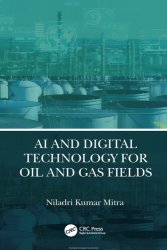 Название: AI and Digital Technology for Oil and Gas Fields Название: AI and Digital Technology for Oil and Gas Fields
Автор: Niladri Kumar Mitra
Издательство: CRC Press
Год: 2025
Страниц: 258
Язык: английский
Формат: pdf (true)
Размер: 10.1 MB
The book essentially covers the growing role of AI in the oil and gas industry, including digital technologies used in the exploration phase, customer sales service, and cloud-based digital storage of reservoir simulation data for modeling. It starts with the description of AI systems and their roles within the oil and gas industry, including the agent-based system, the impact of industrial IoT on business models, and the ethics of robotics in AI implementation. It discusses incorporating AI into operations, leading to the reduction of operating costs by localizing control functions, remote monitoring, and supervision.
This book tries to introduce Artificial Intelligence (AI) as the ability of a computer or a robot controlled by a computer to perform tasks that humans usually do because they require human intelligence and discernment. The primary objective of AI (also called heuristic programming, machine intelligence, or the simulation of cognitive behavior) is to enable computers to perform such intellectual tasks as decision-making, problem-solving, perception, and understanding human communication (in any language, and translating them). AI is a theory and development of computer systems that can perform tasks that normally require human intelligence. Speech recognition, decision-making, and visual perception, for example, are features of human intelligence that AI may possess. AI is also dipping into the digital oilfield well to leverage the latest advancement in intelligent visual monitoring technology to give companies the ability to limit remote site visits while reducing operational expenditure and mitigating safety and environmental risks. Many analog signals—temperature, pressure, strain, and so on—can benefit from some conditioning to improve measurement quality. Filtering is a type of conditioning that removes interference from system signals—also considered knowledge base system and data filtering.
Machine Learning is part of AI. It completes learning from data with specific inputs to the machine. Without explicit programming, computers can learn how to complete tasks using machine learning. Machine learning involves computers learning from data provided to carry out specific tasks. It is an application of AI that involves algorithms and data that automatically analyze and make decisions by itself without human intervention. It describes how a computer performs tasks on its own using previous experiences. User feedback should surround the generalization of the Machine Learning process. Machine Learning contains algorithms for supervised learning, unsupervised learning, and semi-supervised learning, which set them apart from one another. Machine Learning is used for speech recognition, and acoustic models are used for fraud detection in credit cards. Three methods, i.e., statistical methods, computer science, and economics-biology-psychology, are brought together by Machine Learning. This book will not deal with statistical methods.
Python is one of the specific software programming languages used by various software developers. Being one of the best-known programming languages for AI and neural networks, Python has taken a big lead. AI, in combination with Python, is one of the best tools in the operating software system. Python, with its rich technology competency, has an extensive set of libraries for AI and ML. Some of them are Keras, TensorFlow, and Scikit-learn for ML, and NumPy for high-performance scientific computing and data analysis software.
The reasons for choosing Python for AI over other languages are as follows:
- Python offers the minor code among others and is, in fact, 1/5 the number compared to other OOP languages.
- Python has prebuilt libraries like Numpy for scientific computation, SciPy for advanced computing, and PyBrain for ML (Python ML), making it one of the best languages for AI.
- Python developers around the world provide comprehensive support and assistance via forums and tutorials, making the job of the coder easier than any other
popular languages.
- Python is the most flexible of all others, with options to choose between the OOPs approach and scripting. It can also use integrated development environment (IDE) itself to check for most codes and is a boon for developers struggling with different algorithms.
Contents:
1. The Growing Role of Artificial Intelligence in Oil and Gas Industry
2. Artificial Intelligence Agent System
3. Artificial Intelligence and Automatic Control
4. The Components of Trusted Artificial Intelligence
5. Industrial Internet of Things (IIoT)
6. Artificial Intelligence and Robotics
7. Machine Learning and Artificial Intelligence
- Data Science and AI
- Python Libraries for General AI
- Python for Machine Language
- Python Libraries for Natural Language and Text Processing
- Comparison between Python and C++ for AI
8. Intelligent Drilling and Well Completion
9. Reservoir Management and i-Cloud Storage
10. Distributed Digital Control System for Oil and Gas Operations
11. Energizing Future of Digital Technology in Oil and Gas Industry
Скачать AI and Digital Technology for Oil and Gas Fields
|